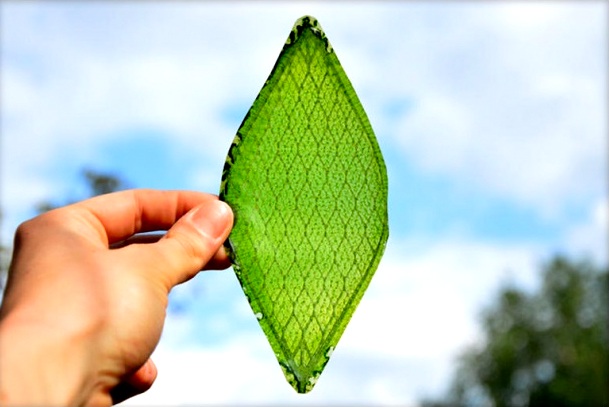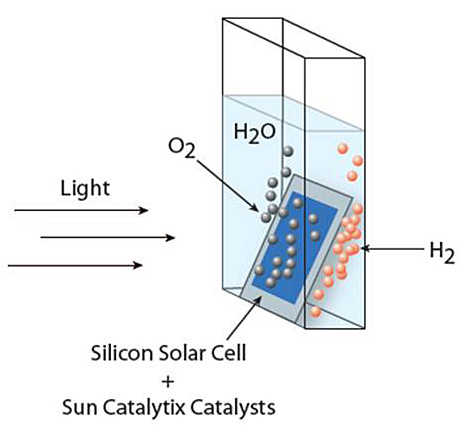Artificial Leaf – The next big thing in the fight against climate change

This topic of “Artificial Leaf – The next big thing in the fight against climate change” is important from the perspective of the UPSC IAS Examination, which falls under General Studies Portion.
What is Artificial Leaf?
- The artificial leaf is a silicon-based technology which produces hydrogen energy (a clean fuel) by utilizing sunlight to split water molecules into hydrogen and oxygen.
- It is designed to mimic photosynthesis, the natural mechanism by which plants utilize sunlight to produce carbohydrates and store energy. But Artificial Leaf is designed to be far more efficient in photosynthesis than plants. Hence it is like a photosynthesis machine.
- The invention of Artificial Leaf is credited to an American Chemist named Daniel G. Nocera and his colleagues in 2011.
- It is an amalgamation of physics, engineering, and biology.
- It is a clean way of producing energy that will someday become the main weapon in the fight against climate change and also as an important power source, particularly in developing nations like India.
How is it different from the natural leaf?
A plant utilizes just 1% of the energy it gets from the sun for converting CO2 and water into carbohydrates or glucose, whereas the artificial leaf can utilize 20% of the energy it receives from the sun to produce Hydrogen.
What is the need for Artificial Leaf?
- The primary application of artificial leaf is the production of clean energy that is Hydrogen. Hydrogen is being used in a variety of different sustainable technologies. But conventional techniques of capturing Hydrogen such as steam reforming and hydraulic fracturing (or fracking) tend to release potentially harmful chemicals into the environment which is not desirable for sustainable development.
- This could solve the major challenge of solar and wind power plants in producing and storing energy when the sun is not shining and the air is still and also the associated costs.
- Around 3 billion people are living in regions that do not have any access to electricity. Hence, there is a need for a simple device like Artificial Leaf that is compatible with local conditions.
- The artificial leaf is highly relevant for countries like India as it is blessed with immense sunlight throughout the year but not adequately translated into energy.
How does it work?
- Artificial Leaf system consists of semiconductors piled up in a way to simulate the natural leaf system. When sunlight strikes the semiconductors, electrons transfer in one direction, generating electric current. The current instantaneously splits water into hydrogen and oxygen.
- The resultant hydrogen gas can then be used for the immediate production of electricity or can be stored for later usage.
- Semiconductors are coated in chemical catalysts such as platinum to speed up the water-splitting reaction.
- The main by-product of this process is water, which is why researchers believe that artificial leaf is the cleanest source of energy generation.
What are the applications of Artificial Leaf?
- It has the potential to transform the transportation sector in a big way by making even the long-distance air travel affordable and environmentally sustainable. It makes the way for the eco-friendly cars to become a common mode of transport in the future since artificial leafs can produce liquid hydrocarbon fuels that could be burned in modern car engines without any major alterations in design or technology.
- Artificial leaf makes hydrogen a renewable source of energy as sunlight and water are abundant on Earth.
- With artificial leaf, people can produce their own electricity and can live far away from the electricity grid, as hydrogen energy can be produced anywhere at any time. It has to be noted that, an estimated one to three bottles of water is enough to power a single household in less-developed regions of the world.
- Researchers also claim that, by using the resultant hydrogen from artificial leaf we can also produce various products such as fertilizers, plastics and drugs by means of using microbes or bacterium.
- It helps mitigate global warming and climate change by reducing carbon footprint, since it absorbs CO2 from the air to generate hydrogen and releasing more oxygen in the process. It is also 100% more efficient in absorbing CO2 from air than natural plant leaf.
- Artifical leaves also help in making the thermal power plants more efficient, because thermal plants produce more CO2 which can be turned into energy to further fuel the power plant. In short, it removes CO2 and at the same time the leaf energy power up the thermal power stations.
- It provides environmental friendly and affordable storage of energy when compared to other renewables such as solar and wind power plants.
Also Read: Seaweeds – From healthy food to climate change mitigation
What are the challenges in the commercialization of Artificial Leaf?
- Efficiency and cost-effectiveness are the two important factors that affect the commercialization process. In initial research, artificial leaf captured only 4.7% of solar energy for producing hydrogen. Artificial leaf technology remains potentially expensive due to lack of cheap and abundant materials in the production process.
- Concerns about the safety of hydrogen fuel storage also restrict the practical implementation.
What are the opportunities for the successful commercialization?
- Devices developed since the initial research achieved efficiencies as higher as 10%.
- Researchers are also working on the cheaper version of catalysts and processes to make the technology cheaper for the large-scale production.
Also read: Offshore wind power – The most unutilized energy potential of India
What is the recent Indian research on the Artificial leaf about?
- In 2017, Council of Scientific and Industrial Research (CSIR) scientists of India developed an artificial leaf device with improved efficiency. They used gold nanoparticles, titanium dioxide, and quantum dots to make the process efficient.
- Quantum dots are semiconductor nanocrystals with distinct properties that depend on the size of the dots. It does not need any external voltage and performs better than existing solar cells. Apart from solar cells quantum dots also have applications in transistors, LEDs, medical imaging and quantum computing.
Way forward
We are already experiencing the harmful effects of global warming such as changing climate and rising water levels to such a degree that would only become severe if we keep on adding more CO2 into the atmosphere. The artificial leaf is a big leap forward in producing environmentally sustainable energy thereby mitigating the harmful effects of climate change as it absorbs the CO2 from the air directly to produce energy. Hence policymakers should actively donate researchers with funds and make relevant policies in order to achieve the desired scale in the artificial leaf production.
The artificial leaf is a big leap forward in producing environmentally sustainable energy thereby mitigating the harmful effects of climate change as it absorbs the CO2 from the air directly to produce energy. Hence policymakers should actively donate researchers with funds and make relevant policies in order to achieve the desired scale in the artificial leaf production.



Good